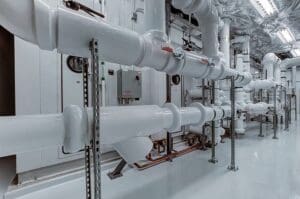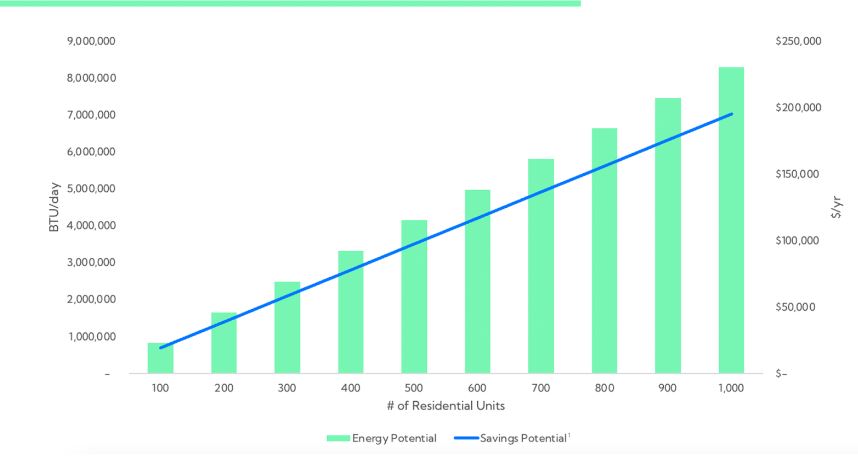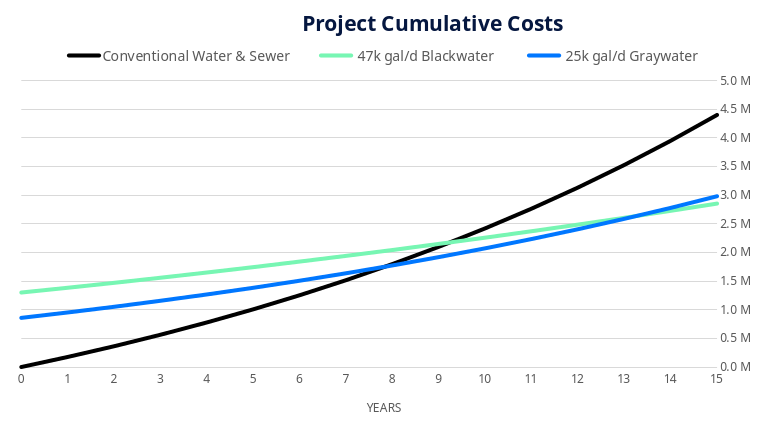Calculating the ROI of water use in buildings


How Does Water Reuse Benefit Building Owners?
Onsite water reuse can also ensure property owners are in compliance with local water reuse regulations, such as those in San Francisco, CA, or can take advantage of local incentives, such as in Austin, TX. As drought across the United States worsens and expands, more cities and states are preparing to adopt similar regulations, like Los Angeles and Arizona.
So how much could you save by incorporating an onsite water reuse system in your upcoming project?
Key ROI Factors for Water Reuse Projects
For many large buildings (>100,000 sq ft), onsite water reuse can save five to six figures annually. The exact amount depends on several factors:
Water Volume
The more water that’s used in the building routinely, the more savings a water reuse system will provide.
Building Size
In general, larger buildings use more water and thus generate more savings with a water reuse system. San Francisco’s onsite water reuse mandate applies to development projects of 100,000 gross square feet or greater.
Property Type
Certain property types see particularly high ROI with water reuse. Ideal candidates include:
- Multifamily residential
- Mixed-use buildings
- Commercial or office buildings
- Data centers
- Student housing
- Community-scale developments
- Hotels & resorts
- Food & beverage processing facilities
- Brewery, wineries and distilleries
New Construction
New construction is the best fit for onsite water reuse systems. It maximizes the ability to reduce upfront water and sewer impact since it’s easier to install the necessary reclaimed water pipes during construction rather than after.
It is possible to retrofit buildings to accommodate water reuse systems, but the ROI is usually less than for new construction. The biggest consideration here is the need to replumb the building to account for purple pipes. Generally, the size and scope of the project determine whether there will be sufficient ROI to justify the retrofit. Some existing buildings can see financial benefits from retrofitting, especially if the reclaimed water is used in cooling towers and irrigation.
System Type
The type of system installed, blackwater or greywater, also has a significant impact on ROI since it determines how much water is being processed and reused. A blackwater system processes all wastewater flows from a building, which allows maximum onsite reuse. A greywater system reuses only a portion of the building flows, and so generates less water for reuse and consequently less savings.
There are some cost tradeoffs between blackwater and greywater systems. Blackwater systems often cost more for equipment, while greywater systems cost more for dual building plumbing.
The amount of blackwater and greywater that is produced is also highly dependent on the property type. Many projects select blackwater for its significantly higher reuse and savings potential.
How We Calculate ROI
At Epic Cleantec, we conduct a free, detailed assessment for each project to calculate its ROI. In this assessment, we:
- Examine the project’s location, size, program, and goals;
- Produce a water balance to understand annual water use for your project and the impact a reuse system can have;
- Identify any available incentives or grants for the location;
- Select a system with the smallest footprint and the highest impact;
- Assess the system’s ROI, including projected annual utility costs and net savings potential.
In general, the larger the building is and the more water it uses, the more onsite water reuse will reduce utility costs and increase the project’s ROI.
Quantifiable Variables for Water Reuse ROI

The most easily quantifiable factors in calculating water reuse ROI include the instant cost reduction in water and sewer utilities and connection fees, insulation against rising water and sewer utility costs (which in many places are increasing by 5-10% a year), and energy savings through heat recovery.
Reduced water and sewer bills, as well as related impact fees, save large building owners an average of 30-50% ($50,000-$1 million) a year on water and sewer-related expenses. Some examples include:
- A 700,000 sq ft. commercial high-rise in San Francisco can save hundreds of thousands of dollars on connection fees and around $160,000 per year with a blackwater reuse system
- A 500-unit residential high-rise in San Diego can save hundreds of thousands of dollars on connection fees and $200,000 per year recycling water for toilet flushing and laundry use
- A 400-unit mixed-use high-rise in Austin can save $150,000-$200,000 per year recycling water for toilet flushing, laundry and cooling towers
Heat recovery can boost water reuse savings as well. Epic Cleantec systems can be customized to include a wastewater heat recovery (WWHR) option. The WWHR system captures the energy from a building’s wastewater, then uses it to preheat domestic hot water. This lowers building heating costs, often by thousands per year.
Additional ROI
In addition to direct savings from water reuse, a secure and decentralized water supply is a strong operational benefit. For example, onsite water reuse improves a building’s resiliency against water scarcity and issues that may arise from our aging water infrastructure, making it more attractive to potential residents.

As climate change becomes an increasingly pressing issue, many residents, tenants and consumers also make choices based on their environmental impact. Onsite water reuse relieves pressure on stressed freshwater and municipal sources and so provides a more sustainable alternative to increasing water scarcity. It also contributes toward ESG goals and LEED certification, which are important validators for climate-conscious consumers and investors.
What Will the ROI Be for My Water Reuse Project?
The only way to know if water reuse makes sense for your project is to perform a water reuse assessment. We recommend one for every building development project over 100,000 square feet. For many projects, onsite water reuse can:
- Provide five to six figures’ worth of water and sewer savings per year – achieving ROI in 3-7 years;
- A significant boost to your sustainability profile;
- Help a project reach LEED goals;
- Drastically improved water security;
- An opportunity to be seen as industry leaders by residents, tenants and investors.

As water scarcity worsens, utility costs rise, and regulations tighten, the ROI of water reuse will only improve. Having professionals calculate the ROI of your project allows you to make an informed decision on whether installing an onsite water reuse solution makes sense for your property.

